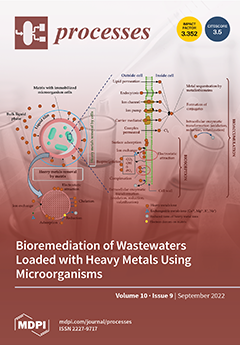Produced water contaminated with oil has adverse effects on human health and aquatic life. Providing an efficient method for the removal of oil from produced water is a challenging task. In this study, the effects of carbon chain length and the cation nature of ionic liquids (ILs) on the removal efficiency of oil from produced water were investigated. For this purpose, seven ILs containing the bis (trifluoromethylsulfonyl) imide (NTf
2) anion, and various cations such as imidazolium, pyridinium, phosphonium, and ammonium, were employed for the removal of oil from produced water via liquid–liquid extraction. The effects of process parameters such as the initial concentration of oil in produced water, contact time, pH, salinity, phase ratio, and temperature on the removal efficiency of oil were studied and optimized. 1-Decyl-3-methyl-imidazolium bis(trifluoromethylsulfonyl)imide ([C
10mim][NTf
2]) (IL4) was found to give the highest oil extraction efficiency of 92.8% under optimum conditions. The extraction efficiency was found to increase with increasing cation alkyl chain length from C
2 to C
10. The extraction efficiency of ILs based on cations follows the order imidazolium > ammonium > phosphonium > anpyridinium. Fourier Transform infrared spectroscopy (FTIR) was used to explore the ILs interaction with oil using [C
10mim][NTf
2] as a model. In addition,
1H and
13C NMR spectra were recorded to obtain a better understanding of the molecular structure of IL and to investigate the peak shifts in H and C atoms. Moreover, the cell viability of the most efficient IL, [C
10mim][NTf
2], in human cells was investigated. It has been concluded that this IL exhibited minimal cytotoxic effects at lower concentrations against human cell lines and is effective for the extraction of oil from aqueous media.
Full article





